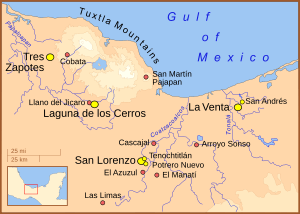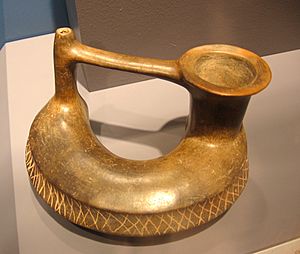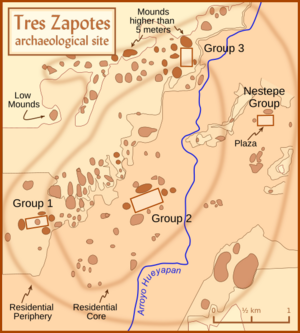Tres Zapotes facts for kids

Tres Zapotes is an amazing ancient site in Mexico. It's where people lived and built cities a very long time ago! This special place is located in the lowlands near the Gulf of Mexico. It was once a major center for the Olmec people, who were one of the earliest advanced civilizations in Mesoamerica.
But Tres Zapotes wasn't just important for the Olmecs. It continued to be a busy place for over 2,000 years! Different cultures, like the Epi-Olmec and Classic Veracruz people, also lived and built here. This long history makes Tres Zapotes a truly unique archaeological site.
Contents
Where in the World is Tres Zapotes?
This ancient city is found in the state of Veracruz, Mexico. It sits near the modern village of Tres Zapotes. The area is special because it's where the Los Tuxtlas Mountains meet the flat lands of the Papaloapan River delta.
This location was perfect for the people who lived there. They could use resources from the forests in the mountains and also from the swamps and rivers in the flat areas. Not far away is an extinct volcano called Cerro el Vigía. This mountain was a great source of strong stones like basalt, which the ancient people used to carve their amazing sculptures. Some of these basalt rocks were huge, even bigger than a car!
A Journey Through Time: The History of Tres Zapotes
The Ancient Olmecs: Giant Heads and Early Cities
Tres Zapotes began to grow into an important city long before 1000 BCE. It became a major center around 900 to 800 BCE. This was around the same time that another big Olmec city, San Lorenzo Tenochtitlan, started to decline. The earliest public buildings at Tres Zapotes were built around 500 BCE.
One of the most exciting discoveries at Tres Zapotes are the two giant stone heads, known as "Monument A" and "Monument Q." These are called Olmec colossal heads. The very first colossal head ever found was discovered near Tres Zapotes in 1862 by José Melgar! These heads are a bit smaller than the ones found at San Lorenzo, but they still show the unique style of the Olmec artists from this area.
Unlike some other Olmec cities, Tres Zapotes didn't just disappear when the main Olmec culture changed around 400 BCE. Instead, the Olmec way of life here slowly changed into something new, which we now call the Epi-Olmec culture.
The Epi-Olmec Period: New Art and Writing
Most of the large stone sculptures you can see at Tres Zapotes come from the Epi-Olmec period. This was a time when the art still looked a bit like Olmec art, but it also started to show new ideas and styles. For example, a stone carving called Stela D shows a scene framed by a monster's mouth. This is similar to an older Olmec carving from La Venta, but Stela D tells a real historical story, not a mythical one.
During this time, something very important happened at Tres Zapotes: a new writing system appeared! It's called the Isthmian script (or Epi-Olmec script). Also, some of the earliest dates written in the Mesoamerican Long Count calendar were found here. This calendar was a very advanced way for ancient people to keep track of time.

This stone shows an ancient date from the Mesoamerican Long Count calendar. The symbols around the date are rare examples of Epi-Olmec script.
The Classic Era: A City Changes
Around 300 CE, the Classic era began. Tres Zapotes continued to be an important regional center, and people kept building mounds. However, other new cities of the Classic Veracruz culture started to grow bigger and more powerful. This meant Tres Zapotes became less central.
By about 900 CE, it seems Tres Zapotes was mostly abandoned. Although, some people did live there again for a shorter time later on.
Stela C: A Calendar from the Past
In 1939, an archaeologist named Matthew Stirling made an incredible discovery at Tres Zapotes: the bottom half of a stone monument called Stela C. This stela was carved from basalt rock. One side shows an Olmec-style carving, possibly a ruler or a mythical creature.
But the other side was even more exciting! It had the oldest Mesoamerican Long Count calendar date ever found at that time. This date, 7.16.6.16.18, matches September 3, 32 BCE, in our modern calendar. There was a bit of a mystery about the first number of the date, but Matthew's wife, Marion Stirling, believed it was a '7'. She was proven right in 1969 when the top half of the stela was finally found!
The back of Stela C also has some of the few remaining examples of the Epi-Olmec script. This stela is a true treasure, helping us understand ancient writing and timekeeping.
How Tres Zapotes Was Organized
Archaeologists have found over 160 mounds and other structures at Tres Zapotes. Most of these were low platforms where people lived. The main groups of buildings from the Epi-Olmec period are called Groups 1, 2, 3, and the Nestepe Group (also known as Group 4).
These groups were spread out, almost 1 kilometer (about half a mile) apart from each other. This suggests that Tres Zapotes might have had a different kind of leadership than some other Olmec cities. Instead of one central ruler, it might have been run by different important families or groups, with each group having its own main area. For example, the two giant stone heads found at Tres Zapotes were not in the central Group 2. Monument A was in Group 1, and Monument Q was in the Nestepe Group.
Each mound group usually had a large open area (a plaza) surrounded by several mounds. There was often a pyramid-shaped mound on one side and a long mound on another. The longer mounds probably held important buildings or homes for the most powerful people. Smaller mounds were likely for other important families or temples.
The size and complexity of these groups varied a lot. Some, like the Nestepe group, had mounds less than 3 meters (about 10 feet) tall. Others, like Groups 2 and 3, had mounds up to 12 meters (about 40 feet) high! This shows that some groups had more power and resources than others.
Visiting the Tres Zapotes Museum
Today, you can visit a museum in the village of Tres Zapotes. Here, you can see some of the amazing Olmec heads and half of the famous Stela C. The other half of Stela C is in a museum in Mexico City. It's a great way to learn more about this incredible ancient civilization!
See also
 In Spanish: Tres Zapotes para niños
In Spanish: Tres Zapotes para niños



